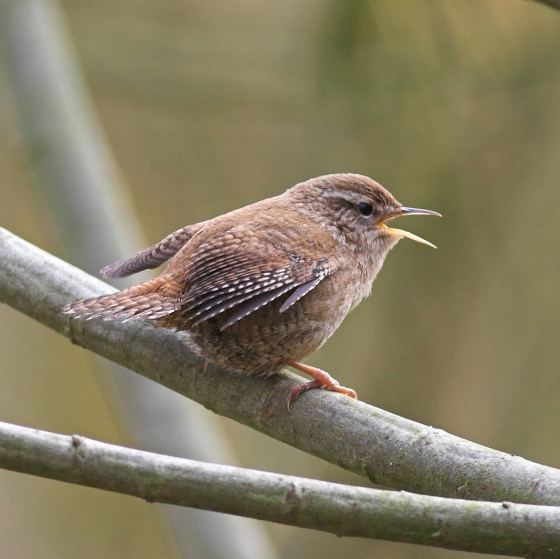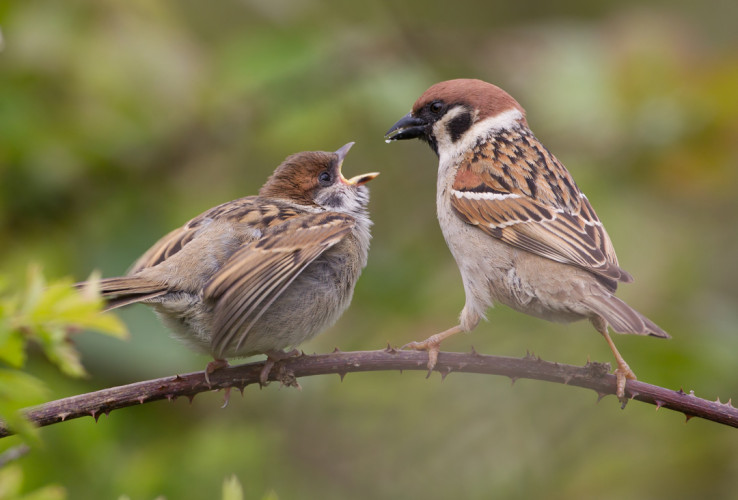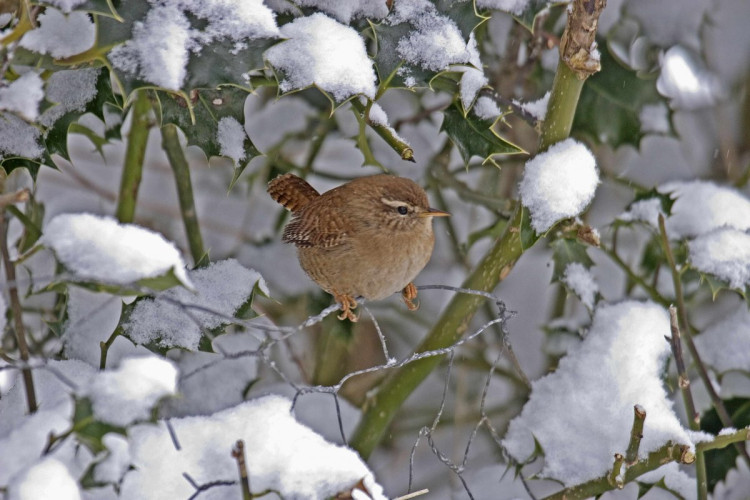Wren
Troglodytes troglodytes (Linnaeus, 1758)
WR
 WREN.
WREN.  10660
10660

Family: Passeriformes > Troglodytidae

Small and chestnut brown with a short cocked tail, the Wren is one of our most widespread birds and can be found across Britain & Ireland.
The Wren is often heard before it is seen, giving its scolding 'tik-tik-tik-tik' alarm call or in full song which - for such a tiny bird - is remarkably loud! It is found in a wide variety of habitats, from rural farmland, woodland and uplands to cities, towns and gardens.
The Wren is the most numerous wild breeding bird in the UK, although its numbers can fluctuate, with declines after cold winters. Where it occupies far flung islands, the breeding populations have become so isolated that new subspecies have evolved; hirtensis on Fair Isle and hebridensis on St Kilda are larger and darker than their mainland cousins, and their songs differ slightly too.
Exploring the trends for Wren
Our Trends Explorer will also give you the latest insight into how the UK's Wren population is changing.
trends explorerIdentification
Wren identification is usually straightforward.
SONGS AND CALLS
Listen to example recordings of the main vocalisations of Wren, provided by xeno-canto contributors.
Call
Song
Develop your bird ID skills with our training courses
Our interactive online courses are a great way to develop your bird identification skills, whether you're new to the hobby or a competent birder looking to hone your abilities.
Browse training coursesStatus and Trends
Population size and trends and patterns of distribution based on BTO surveys and atlases with data collected by BTO volunteers.
CONSERVATION STATUS
This species can be found on the following statutory and conservation listings and schedules.
POPULATION CHANGE
The Wren's current UK population estimate is the highest for any species and, on the latest figures, one in eight of our breeding birds is a Wren (APEP4). Abundance can vary sharply from year to year, however. Wren numbers in the UK were greatly depleted by the cold winter of 1962/63 (Marchant et al. 1990). Following a rapid recovery up to the mid 1970s, abundance fell again in response to a further series of cold winters, only to return to its previous high level. Following recent severe winters, numbers were somewhat depleted once more, especially in Scotland and Northern Ireland, but have now recovered. The BBS map of change in relative density between 1994-96 and 2007-09 indicates that there was a gradient of change over that period, from minor decrease in parts of southern England to strong increase in North Wales, northern England and mainland Scotland. There has been an increase across Europe since 1980 (PECBMS: PECBMS 2020a>).
| UK breeding population |
+107% increase (1967–2022) 
|
Exploring the trends for Wren
Our Trends Explorer will also give you the latest insight into how the UK's Wren population is changing.
trends explorerDISTRIBUTION
The Wren is ubiquitous in Britain & Ireland, being present in at least 97% of squares throughout the year and absent only from some of the highest-altitude areas in Scotland. Densities are generally higher in Ireland than in Britain. Densities are also lower in upland areas.
Occupied 10-km squares in UK
| No. occupied in breeding season | 2949 |
| % occupied in breeding season | 98 |
| No. occupied in winter | 2935 |
| % occupied in winter | 97 |
European Distribution Map
European Breeding Bird Atlas 2
Breeding Season Habitats
| Most frequent in |
Deciduous Wood 
|
| Also common in | Scrub, Pasture Farmland, Villages, Towns, Coniferous Wood |
Relative frequency by habitat
Relative occurrence in different habitat types during the breeding season.

DISTRIBUTION CHANGE
Given its widespread nature, there is little scope for further range gains. Atlas data suggest a 4% range expansion overall since the 1981–84 Winter Atlas, most notably across northern Scotland; this probably reflects increasingly mild winters and improved coverage in these areas of low Wren density.
Change in occupied 10-km squares in the UK
| % change in range in breeding season (1968–72 to 2008–11) | +0.5% |
| % change in range in winter (1981–84 to 2007–11) | +5.3% |
SEASONALITY
Wren is a common and easily detected species, especially in spring when singing and may be recorded on 60% of complete lists.

Movement
Information about movement and migration based on online bird portals (e.g. BirdTrack), Ringing schemes and tracking studies.
RINGING RECOVERIES
View a summary of recoveries in the Online Ringing Report.
Foreign locations of birds ringed or recovered in Britain & Ireland

Biology
Lifecycle and body size information about Wren, including statistics on nesting, eggs and lifespan based on BTO ringing and nest recording data.
PRODUCTIVITY & NESTING
Exploring the trends for Wren
Our Trends Explorer will also give you the latest insight into how the UK's Wren population is changing.
trends explorerSURVIVAL & LONGEVITY
View number ringed each year in the Online Ringing Report
Maximum Age from Ringing 
|
7 years 3 months 6 days (set in 2004) 
|
Typical Lifespan 
|
2 years with breeding typically at 1 year |
Adult Survival 
|
0.319±0.021  
|
Juvenile Survival 
|
0.263 (in first year) 
|
Exploring the trends for Wren
Our Trends Explorer will also give you the latest insight into how the UK's Wren population is changing.
trends explorerBIOMETRICS
Wing Length 
|
Adults | 48.8±2.1 | Range 46–52mm, N=17388 |
| Juveniles | 48.5±2 | Range 46-52mm, N=23612 | |
| Males | 50.3±1.7 | Range 48–52.5mm, N=3049 | |
| Females | 47.6±1.7 | Range 45–50mm, N=3808 |
Body Weight 
|
Adults | 9.90±1.6 | Range 8.30–11.5g, N=13989 |
| Juveniles | 9.50±1 | Range 8.10–11.2g, N=18343 | |
| Males | 10.5±0.7 | Range 9.50–11.5g, N=2353 | |
| Females | 9.80±2 | Range 8.30–11.6g, N=3007 |
Feather measurements and photos on featherbase 
CODES & CLASSIFICATION
Ring size 
|
AA |
Field Codes 
|
2-letter: WR | 5-letter code: WREN. | Euring: 10660 |
For information in another language (where available) click on a linked name
Research
Interpretation and scientific publications about Wren from BTO scientists.
CAUSES AND SOLUTIONS
Causes of change
There is good evidence that mortality rates are severely affected by cold winter weather. Thus, a warming climate may have benefited this species, although there is only circumstantial evidence for this.
Further information on causes of change
There has been a reduction in the failure rate of nests at the egg stage, reflected in larger brood sizes and an increase in fledglings per breeding attempt, but the effects of productivity are overshadowed by the strong influence of winter weather on this species.
There is good evidence that annual numbers are influenced by mortality rates and that mortality may be very high in severe winters (Peach et al. 1995b, Morrison et al. 2016a). Wren survival rates were negatively correlated with the number of snow days in winter (Peach et al. 1995b) and with the number of frost days in winter (Morrison et al. 2016a). Robinson et al. (2007b) showed that survival is related to the strength of the North Atlantic Oscillation, an ocean-scale weather pattern that has a strong influence on UK weather. First-year survival was more influenced by weather than that of adult birds, although adult survival was also affected. Morrison et al. (2016a) found that northern UK populations were more resilient that southern populations, with a higher number of frost days required before population levels were affected. These observations suggest that a warming climate may benefit this species, and recent modelling also suggests that climate change may have had a positive impact on the long-term trend for this species (Pearce-Higgins & Crick 2019).
Information about conservation actions
There are currently no conservation concerns about the Wren, and in fact this species may benefit from climate change as this is likely to result in warmer winters leading to higher survival (see Causes of Change, above). Therefore, no specific conservation actions are currently required to benefit the Wren.
PUBLICATIONS (2)

Drivers of the changing abundance of European birds at two spatial scales
Study highlights significant losses of European birds
This piece of research explores the question of measuring and detecting biodiversity change for European birds, which are well monitored in many European countries thanks to ongoing monitoring prog

Winter wren populations show adaptation to local climate
Northern Wrens weather the winter better than southerners
BTO research reveals that one of our most widespread songbirds – the Wren – varies in its resilience to winter weather, depending on where in Britain it lives. Scottish Wrens are larger than those living in southern Britain, and are more resilient to hard winter frosts.
Links to more studies from ConservationEvidence.com
- Removal of old nest material from the nesting sites of house wrens: effects on nest site attractiveness and ectoparasite loads
- Food-supplementation does not override the effect of egg mass on fitness-related traits of nestling house wrens
- Calcium supplementation of breeding birds: directions for future research
Would you like to search for another species?













Share this page